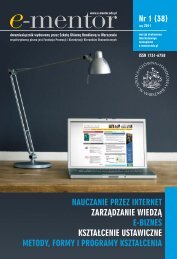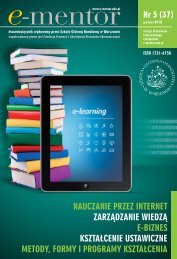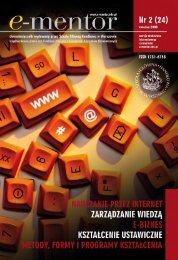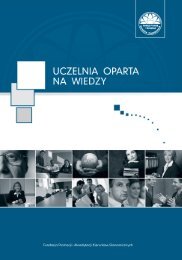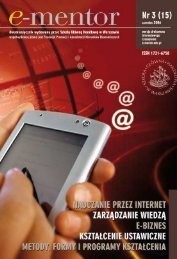metody, formy i programy ksztaÅcenia - E-mentor
metody, formy i programy ksztaÅcenia - E-mentor
metody, formy i programy ksztaÅcenia - E-mentor
You also want an ePaper? Increase the reach of your titles
YUMPU automatically turns print PDFs into web optimized ePapers that Google loves.
Experience as the Foundation for Authentic Learning OnlineGeographically distributed students studying onlinetypically note a strong sense of learning throughcommunity in online classes in which instructorsfacilitate open environments for the discussion, mediation,and resolution of difficult dialogues that ultimatelyreinforce complex understanding 63 . The virtualenvironment offers a wealth of options by which tofurther continuous dialogue, for example, through theuse of such tools as asynchronous email or threadeddiscussion forums, real time conferencing platforms,or basic chat and instant messaging functions 64, 65 .Such approaches used in facilitating interaction andanalyses enable engaging learning environments forthe experimentation with and interpretation of personallymeaningful and academically relevant appliedexperiences 66, 67, 68 .Facilitating Interactive and Collaborative LearningCollaborative learning occurs as the result of activecommunity participation by all stakeholders, theoutcome of which is two-fold: the generation of newareas of knowledge and skill areas, and the acquisitionof interpersonal abilities particularly relevant toeffective participation in career settings 69 . Experientiallearning pursuits and instructional goals mergewithin the context of collaboration that enables theactualization of logical connections between academictheory and practical application 70 . Extensive researchidentifies the importance of interaction and collaborationto intellectual growth, social development,and academic learning 71, 72, 73, 74 . In many senses thevirtual classroom environment is naturally conduciveto building collaboration through community buildingactivities based in the learning environment as wellas at on site placements 75 . When learning is situatedin an instructional framework that promotes the explorationof personal awareness, processes of criticalreflection and inquiry often take flight in the form ofdeveloping relationships, commitments to social andcivic interests, community and political engagement,and creative and intellectual pursuits. The goal ofcollaboration, as opposed to that of cooperation, isthe evolution of a self-directedness and autonomy thatenables students’ capacity for interpreting experiencesand applying them to areas of new learning 76 .Certainly, the integration of technologies in thefacilitation of the most basic communications andinteractions contributes to the success of collaborationin a blended learning environment. Not onlydo media enable interpersonal connections, but alsothey are instrumental to the accomplishment of manytasks centered in placements, thus further facilitatingthe distribution of information and the organizationof shared responsibilities. The use of technologies inthis manner, then, is critical to the accomplishmentof both individual learning goals and work-basedresponsibilities, as well as to the collaboration thatenables the realization of such outcomes.Emphasizing Learner Centerednessand Self-DirectednessAn important approach to facilitating an environmentcentered on student learning is the promotionof self-directedness within the context of experience,emphasizing participants’ control of and responsibilityto learning and meaning making that is situated inaction 77 . Learner-centered teaching approaches areemphasized in literature related to workplace andexperiential learning as well as online education insofaras these environments recognize and foster thedevelopment of self-directedness and autonomy keyto achieving individual learning goals. The promotionof autonomy does not mean that students learn inisolation, as the generation of self-knowledge cannotoccur in the absence of a social environment 78 .Such settings require a degree of negotiation andaccountability related to task accomplishment, collaboration,self-regulation, and overall participation 79 .63P. Shea, A Study of Students’ Sense of Learning Community in Online Environments, „The Journal of Asynchronous Learning Networks”2006, Vol. 10, No. 1, p. 35–44.64S. Barab, M. Thomas, H. Merrill, Online Learning: From Information Dissemination to Fostering Collaboration, op.cit.65S. Meyers, Using Transformative Pedagogy when Teaching Online, op.cit.66P. Cranton, Understanding and Promoting Transformative Learning, Jossey-Bass, San Francisco 2006.67S. Meyers, Using Transformative Pedagogy when Teaching Online, op.cit.68S. Scott, The Social Construction of Transformation, „Journal of Transformative Education”, 2003, No. 1 (3), http://jtd.sagepub.com/cgi/content/abstract/1/3/264.69E.F. Barkley, K.P. Cross, C.H. Major, Collaborative Learning Techniques: A Handbook for College Faculty, Jossey-Bass, San Francisco2005.70H. McCracken, Virtual Learning Communities: Facilitating Connected Knowing, [in:] The Encyclopedia of Distance Learning, (2nd Ed.),IGI Global, Hershey, PA 2005.71A. Astin, What Matters in College? Jossey-Bass, San Francisco 1993.72K.A. Feldman, T.M. Newcomb, The Impact of College on Students, Jossey-Bass, San Francisco 1969.73R.J. Light, The Harvard Assessment Seminars, 2 nd Report, Harvard University, Graduate School of Education and Kennedy Schoolof Government, Cambridge, MA 1992.74E.T. Pascarella, P.T. Terenzini, How College Affects Students, Jossey-Bass, San Francisco 1991.75H. McCracken, Furthering Connected Teaching and Learning Through the Use of Virtual Learning Communities, op.cit.76E.F. Barkley, K.P. Cross, C.H. Major, Collaborative Learning Techniques: A Handbook for College Faculty, op.cit.77N. Zepke, L. Leach, Contextualised Meaning Making: One Way of Rethinking Experiential Learning and Self-Directed Learning, op.cit.78D.R. Garrison, Self-Directed Learning: Toward a Comprehensive Model, op.cit.79N. Solomon, Workplace Learning as Cultural Technology, „New Directions in Adult and Continuing Education” 2001, No. 92,p. 41–51.czerwiec 2011 95



